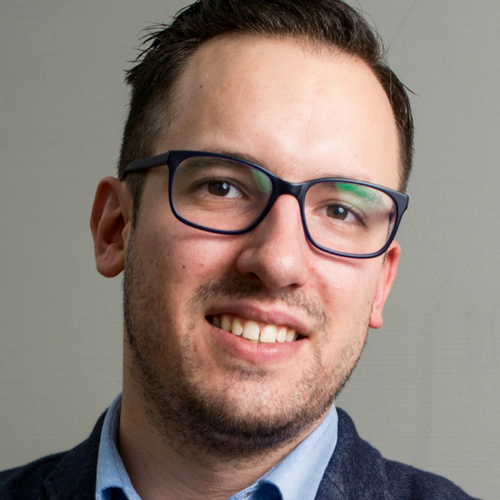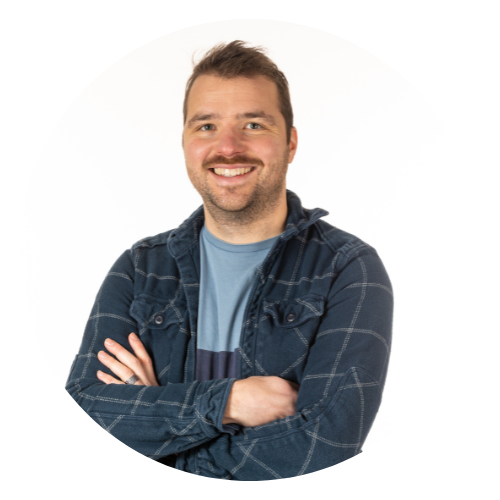Hi there. The fact that you’re reading this means you’re itching to start investing in innovation – we know the feeling! Evidently, we needn’t explain that coming up with an amazing and, above all, viable idea will prove vital to your success. No worries, though, because our Innovation experts have got you covered. In this post we’ll walk you through the first steps we take when innovating for clients. We’ll tell you all about the Double Diamond approach and give you plenty of tips to get inspired and come up with a winning viable idea all on your own – and in just three steps. Ready to start this innovation journey? Let’s go, go, go!
The Double Diamond is an innovator’s best friend
By now you’re probably wondering where to start. And what’s that diamond approach thingy anyway? Well, first things first: the Double Diamond approach is an iterative process of diverging and converging. At AE, we like to refer to this approach as the ‘Empathize and Ideate’ phase of our innovation path.
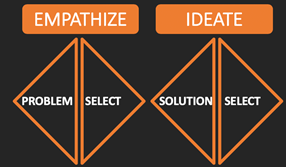
1. Empathize with the client
We start our innovation journey by investigating the problem(s) our client experiences. Looking back on previous projects, we can confidently say this one of the most important steps towards innovation you can take. Because how can you build a solution if you don’t have a clear view of the problem you’re supposed to be fixing, right? Love the problem, not the solution, as our expert innovators are always quick to point out. Anyway, you may think you know exactly what your client wants, but the truth is you really need empathize with them and put yourself in their position. At AE, we find the most efficient technique to truly get inside the customer’s mind is using personas or empathy maps.
Basically, this step comes down to defining who your client is, what keeps them awake at night and what problems they face in their daily struggle to get the job done. Defining pains and potential gains will help you understand the challenges your client faces. This is where establishing a customer journey comes in handy. A customer journey is, as the term suggests, the journey a client goes through in their bid to complete their task(s) successfully.
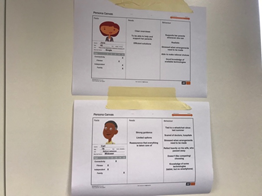
Keep an open mind – and get out of the building!
Remember, we’re right in the middle of an iterative process of diverging and converging. So, when you’re carrying out the persona exercise, make sure you keep an open mind and don’t hesitate to think out of the box. After all, you want to define as many problems as possible so that you have plenty to converge into a smaller amount of specific problems you can fix.
In this converging phase, AE always define the ultimate problem that requires solving. We then start to validate our assumptions regarding that problem. Our ultimate tip for you: get out of the building and talk to your clients! (Okay, we may have stolen that one from Steve Blank. But it’s still central to our approach and we’ll surely write a whole series of posts devoted to the topic sometime soon). Remember that, at this point in the innovation journey, you can only assume you’re right. If your client does not confirm your assumptions first, you risk building something nobody needs.
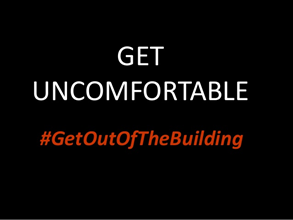
2. Ideate: diverge and then converge
Once you’ve properly defined the problem your client is struggling with, it’s time to look for potential solutions – mind the plural! This is what we call the divergent part of the Ideation phase, where we try to gather as many solutions to the problem as possible. Note that brainstorming may be harder than you think. If you have trouble finding the right technique, we suggest you read up on our tips for accelerating brainstorm sessions. Just keep in mind that all ideas are valuable – restrictions only kill creativity.
Votes for everyone
Done brainstorming? Great! But now the challenge really starts: converging. You’ve probably got tens or even hundreds of ideas. Implementing each of them would take years and, let’s be honest, is highly unlikely to be worth your time (not to mention your money). So, try to combine ideas into categories (solutions, technologies, features, …) and take things from there. Next, determine whether the ideas you jotted down are feasible in the short term or in the long term. Short-term solutions tend to be low-hanging fruits which you can implement in the existing organisation via process optimization or quick-fix projects. Long-term ideas, by contrast, require a bit more thought before you dive in. If you’re having trouble selecting the ultimate solution to the problem you defined in the previous step, we find a voting mechanism* can work wonders. At AE, we believe in having buy-in from the entire team rather than making top-down decisions.
* Let voters hand out (fake) money to the idea they like the most. We believe this subconsciously makes people more cautious in their choices, ultimately selecting not the idea they find the sexiest but the idea which they believe can stand the test of what we at AE like to call the three value lenses.
Three value lenses to look through
Admittedly, having everyone vote* doesn’t necessarily lead to a great idea. To determine the best viable idea, AE cast their vote by looking through three different value lenses in the process. This basically means we check the idea for:
- viability: what’s the business value?
- feasibility: is the idea technologically viable?
- likability: will the client like this solution?
Any idea that ticks all three boxes is worth investigating further.
Prioritized backlog
Have you counted all the votes? Awesome! Your next step is setting up a prioritized backlog. Once again, it’s time to get out of the building with a Minimal Testable Product to validate the assumptions you’ve made regarding the solution your team chosen. (We discuss this in more detail in our next post).
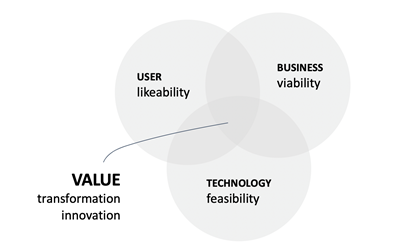
3. Still looking for a viable idea? Get inspired!
If you’re still scratching your head wondering what to innovate, we’ve got plenty of tips for you to get inspired:
- Listen to your client’s feedback. Build a forum, invite them, send out questionnaires, … anything goes.
- Visit one of the many inspirational events out there. Each sector has its special gatherings to get you buzzing with ideas (we recommend keeping an eye on The Next Web especially).
- Some people just aren’t interested in what others have to say about viable ideas, preferring to experience things for themselves. For those who like to get their hands dirty, we suggest participating in our annual hackathon.
That’s all for now, folks! We hope you can put our tips for finding a viable idea to good use. Remember to always question what you ‘know’ and to think broadly at first and then narrow things down to a concrete solution.
Please like or share if you wish to inspire others! And feel free to give us a shout if you have any questions or remarks.

